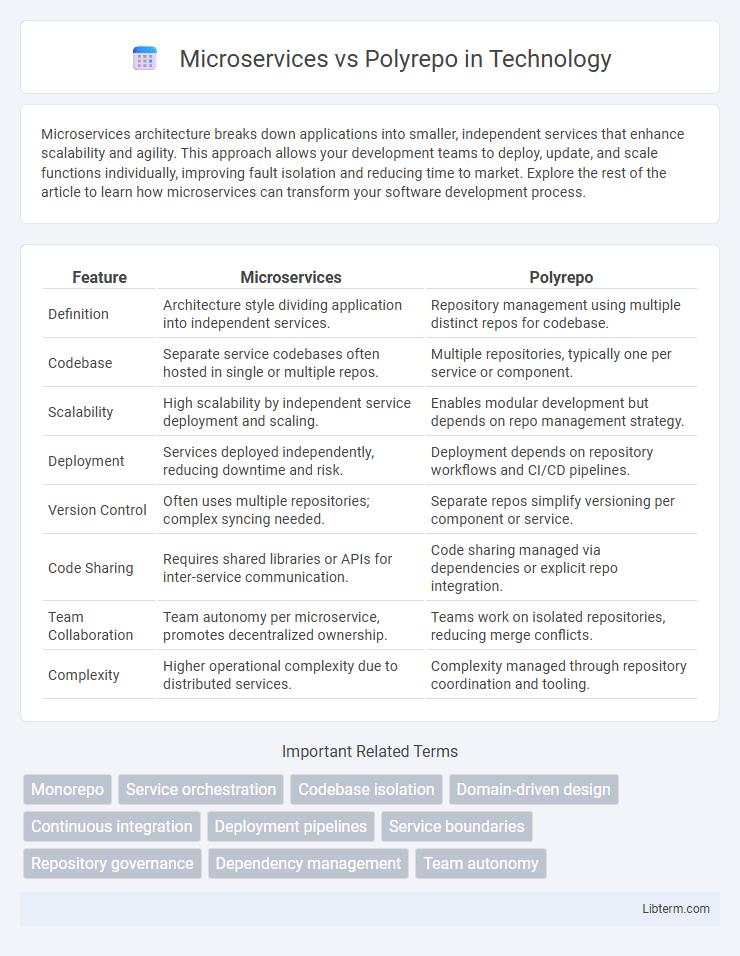Microservices architecture breaks down applications into smaller, independent services that enhance scalability and agility. This approach allows your development teams to deploy, update, and scale functions individually, improving fault isolation and reducing time to market. Explore the rest of the article to learn how microservices can transform your software development process.
Table of Comparison
| Feature | Microservices | Polyrepo |
|---|---|---|
| Definition | Architecture style dividing application into independent services. | Repository management using multiple distinct repos for codebase. |
| Codebase | Separate service codebases often hosted in single or multiple repos. | Multiple repositories, typically one per service or component. |
| Scalability | High scalability by independent service deployment and scaling. | Enables modular development but depends on repo management strategy. |
| Deployment | Services deployed independently, reducing downtime and risk. | Deployment depends on repository workflows and CI/CD pipelines. |
| Version Control | Often uses multiple repositories; complex syncing needed. | Separate repos simplify versioning per component or service. |
| Code Sharing | Requires shared libraries or APIs for inter-service communication. | Code sharing managed via dependencies or explicit repo integration. |
| Team Collaboration | Team autonomy per microservice, promotes decentralized ownership. | Teams work on isolated repositories, reducing merge conflicts. |
| Complexity | Higher operational complexity due to distributed services. | Complexity managed through repository coordination and tooling. |
Introduction to Microservices Architecture
Microservices architecture divides applications into loosely coupled, independently deployable services that focus on specific business functionalities, enabling scalability and faster development cycles. Each microservice can be developed and maintained by separate teams, often stored in individual repositories to enhance modularity and version control. This approach contrasts with polyrepo strategies, which manage multiple microservices in separate repositories to facilitate isolation, streamlined collaboration, and easier integration testing.
Understanding Polyrepo Structure
Polyrepo architecture involves managing multiple, distinct repositories for various microservices, promoting clear separation of concerns and independent version control for each service. This structure allows development teams to work autonomously, reducing potential conflicts and enabling tailored deployment cycles per microservice. Effective use of polyrepo enhances scalability and maintains service decoupling, critical in complex microservices ecosystems.
Key Differences Between Microservices and Polyrepo
Microservices architecture divides an application into independently deployable services, each handling specific business functionalities, while polyrepo is a codebase management strategy using multiple repositories for different components or services. Microservices emphasize service isolation and scalability, enabling teams to develop and deploy services autonomously, whereas polyrepo structures the code into separate repositories to improve modularity and version control. Unlike monorepos that consolidate code in a single repository, polyrepo requires robust dependency management and coordination between repositories, posing unique challenges for integration and release processes.
Benefits of Microservices Approach
Microservices architecture enhances scalability and flexibility by breaking down applications into independently deployable services, enabling faster development cycles and easier maintenance. This approach improves fault isolation, ensuring a failure in one service does not impact the entire system, which increases overall system resilience. Furthermore, microservices facilitate technology diversity by allowing teams to choose the best tools and languages for each service, boosting innovation and efficiency.
Advantages of Polyrepo Organization
Polyrepo organization enhances version control granularity by isolating services into separate repositories, enabling teams to deploy and update microservices independently without risking unintended side effects. This structure improves scalability as development teams can work in parallel, reducing merge conflicts and streamlining continuous integration pipelines. Polyrepo also facilitates clearer access control, allowing permission settings to be fine-tuned per repository, which increases security and maintains better audit trails across services.
Challenges of Microservices Implementation
Microservices implementation faces challenges such as increased complexity in managing distributed systems, leading to problems with service discovery, load balancing, and inter-service communication. Ensuring data consistency and handling eventual consistency across decentralized databases can complicate transaction management. Furthermore, deploying and monitoring numerous independent services requires robust DevOps practices and sophisticated tooling to maintain reliability and scalability.
Limitations of Polyrepo Strategy
Polyrepo strategy often leads to increased complexity in managing dependencies and versioning across multiple repositories. This approach can result in fragmented codebases, making integration and consistency challenging for development teams. Scalability issues also arise as the number of repositories grows, causing overhead in continuous integration and deployment processes.
Use Cases: When to Choose Microservices
Microservices architecture is ideal for complex, scalable applications requiring independent deployment, such as large e-commerce platforms, fintech systems, and real-time analytics services. This approach supports continuous delivery and integration by isolating services, allowing teams to work autonomously and deploy updates without impacting the entire system. When rapid development, fault isolation, and technology heterogeneity are critical, microservices offer greater flexibility and resilience compared to monolithic or polyrepo structures.
Use Cases: When Polyrepo Makes Sense
Polyrepo architecture excels in scenarios where independent teams manage distinct microservices that require separate versioning and deployment cycles, enabling greater autonomy and reduced coupling. It is particularly beneficial for large-scale enterprises with complex systems needing scalable development environments and targeted security policies per repository. Organizations adopting continuous integration and continuous delivery (CI/CD) pipelines for microservices can leverage polyrepo to streamline workflows and minimize cross-service dependencies.
Best Practices for Integrating Microservices with Polyrepo
Integrating microservices with a polyrepo approach enhances modularity and autonomy by maintaining separate repositories for each service, allowing independent development and deployment cycles. Best practices include implementing consistent API versioning, leveraging automated CI/CD pipelines for each repository, and establishing robust service discovery mechanisms to ensure seamless communication across services. Emphasizing comprehensive documentation and enforcing standardized coding guidelines across repositories mitigate integration challenges and improve maintainability in polyrepo-managed microservices architectures.
Microservices Infographic

 libterm.com
libterm.com